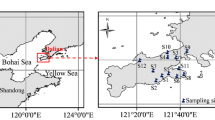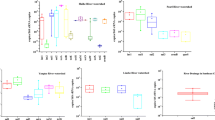Abstract
Antibiotics as a type of environmental contaminants are typically exposed to chemical mixtures over long periods of time, so chronic combined toxicity is the best way to perform an environmental risk assessment. In this paper, the individual and combined toxicity of sulfonamides (SAs), sulfonamide potentiators (SAPs), and doxycycline hyclate (DH) were tested on gram-positive (Bacillus subtilis, B. subtilis) and gram-negative (Escherichia coli, E. coli) bacteria. The individual toxicity of antibiotics on the two bacteria could be ranked in the same order: SAs < SAPs < DH. But E. coli was more sensitive than B. subtilis to the antibiotics, which was likely due to both the different abilities of antibiotics to pass through the cell membrane and the varied capacities to bind target proteins between the two bacteria. In addition, the binary mixtures of SAs–SAPs, SAs–DH, and SAs–SAs exhibited synergistic, antagonistic, and additive effects on both of the bacteria but in different magnitudes as represented by the toxicity units (TU). And we found the different TU values were result from the different effective concentrations of antibiotic mixtures based on the approach of molecular docking and quantitative structure–activity relationships (QSARs). Moreover, from the results of risk assessment, it should be noted that the mixture of SAs and other antibiotics may pose a potential environmental risk assessment due to their combined action with the current environmentally realistic concentrations.




Similar content being viewed by others
References
Broderius, S. J., Kahl, M. D., Elonen, G. E., Hammermeister, D. E., & Hoglund, M. D. (2005). A comparison of the lethal and sublethal toxicity of organic chemical mixtures to the fathead minnow (Pimephales promelas). Environmental Toxicology and Chemistry, 24(12), 3117–3127.
Calabrese, E. J., Hoffmann, G. R., Stanek, E. J., & Nascarella, M. A. (2010). Hormesis in high-throughput screening of antibacterial compounds in E coli. Human & Experimental Toxicology, 29(8), 667–677.
Cassee, F. R., Groten, J. P., Bladeren, P. J. V., & Feron, V. J. (1998). Toxicological evaluation and risk assessment of chemical mixtures. Critical Reviews in Toxicology, 28(1), 73–101(129).
De Liquoro, M., Fioretto, B., Poltronieri, C., & Gallina, G. (2009). The toxicity of sulfamethazine to Daphnia magna and its additivity to other veterinary sulfonamides and trimethoprim. Chemosphere, 75(11), 1519–1524.
Deng, Z., Lin, Z., Zou, X., Yao, Z., Tian, D., Wang, D., et al. (2012). Model of hormesis and its toxicity mechanism based on quorum sensing: a case study on the toxicity of sulfonamides to photobacterium phosphoreum. Environmental Science & Technology, 46(14), 7746–7754.
Gálvez, A. (1989). Bactericidal and bacteriolytic action of peptide antibiotic AS-48 against gram-positive and gram-negative bacteria and other organisms. Research in Microbiology, 140(1), 57–68.
Gao, Y., Lin, Z., Chen, R., Wang, T., Liu, S., Yao, Z., et al. (2012). Using molecular docking to compare toxicity of reactive chemicals to freshwater and marine luminous bacteria. Molecular Informatics, 31(11–12), 809–816.
García, M. J. (2009). Combining chemical analysis and ecotoxicity to determine environmental exposure and to assess risk from sulfonamides. Trac Trends in Analytical Chemistry, 28(6), 804–819.
Gleckman, R., Alvarez, S., & Dw, J. (1979). Drug therapy reviews: trimethoprim-sulfamethoxazole. American Journal of Hospital Pharmacy, 36(7), 893–906.
González-Pleiter, M., Gonzalo, S., Rodea-Palomares, I., Leganés, F., Rosal, R., Boltes, K., et al. (2013). Toxicity of five antibiotics and their mixtures towards photosynthetic aquatic organisms: implications for environmental risk assessment. Water Research, 47(6), 2050–2064.
Halling-Sørensen, B., Sengeløv, G., & Tjørnelund, J. (2002). Toxicity of tetracyclines and tetracycline degradation products to environmentally relevant bacteria, including selected tetracycline-resistant bacteria. Archives of Environmental Contamination and Toxicology, 42(3), 263–271.
Hu, X., Zhou, Q., & Luo, Y. (2010). Occurrence and source analysis of typical veterinary antibiotics in manure, soil, vegetables and groundwater from organic vegetable bases, northern China. Environmental Pollution, 158(9), 2992–2998.
Jiang, L., Lin, Z., Hu, X., & Yin, D. (2010). Toxicity prediction of antibiotics on luminescent bacteria, Photobacterium phosphoreum, based on their quantitative structure–activity relationship models. Bulletin of Environmental Contamination and Toxicology, 85, 550–555.
Jiang, L., Hu, X., Yin, D., Zhang, H., & Yu, Z. (2011). Occurrence, distribution and seasonal variation of antibiotics in the Huangpu River, Shanghai, China. Chemosphere, 82(6), 822–828.
Kümmerer, K. (2009a). Antibiotics in the aquatic environment—a review—part I. Chemosphere, 75(4), 417–434.
Kümmerer, K. (2009b). Antibiotics in the aquatic environment—a review—part II. Chemosphere, 75(4), 435–441.
Kemper, N. (2008). Veterinary antibiotics in the aquatic and terrestrial environment. Ecological Indicators, 8(1), 1–13.
Kim, Y., Choi, K., Jung, J., Park, S., Kim, P., & Park, J. (2007). Aquatic toxicity of acetaminophen, carbamazepine, cimetidine, diltiazem and six major sulfonamides, and their potential ecological risks in Korea. Environment International, 33, 370–375.
Kim, S. C., & Carlson, K. (2007). Quantification of human and veterinary antibiotics in water and sediment using SPE/LC/MS/MS. Analytical and Bioanalytical Chemistry, 387(4), 1301–1315(1315).
Li, B., Zhang, T., Xu, Z., & Fang, H. H. (2009). Rapid analysis of 21 antibiotics of multiple classes in municipal wastewater using ultra performance liquid chromatography-tandem mass spectrometry. Analytica Chimica Acta, 645(1/2), 64–72.
Li, C., Chen, J., Wang, J., Ma, Z., Han, P., Luan, Y., & Lu, A. (2015). Occurrence of antibiotics in soils and manures from greenhouse vegetable production bases of Beijing, China and an associated risk assessment. Science of the Total Environment, 521, 101–107.
Lin, Z., Ping, Z., Kong, D., Yin, K., & Cai, Z. (2005). The ratios of individual chemicals in a mixture determine the degree of joint effect: the climax hypothesis. Archives of Environmental Contamination and Toxicology, 49(1), 1–8.
Martínez, J. L. (2008). Antibiotics and antibiotic resistance genes in natural environments. Science, 321(5887), 365–367.
Mengelers, M. J., Hougee, P. E., Janssen, L. H., & As, V. M. (1997). Structure-activity relationships between antibacterial activities and physicochemical properties of sulfonamides. Journal of Veterinary Pharmacology & Therapeutics, 20(4), 276–283.
Park, S., & Choi, K. (2008). Hazard assessment of commonly used agricultural antibiotics on aquatic ecosystems. Ecotoxicology, 17(6), 526–538.
Pei, R. (2006). Effect of river landscape on the sediment concentrations of antibiotics and corresponding antibiotic resistance genes (ARG). Water Research, 40(12), 2427–2435.
Preidis, G. A., & Versalovic, J. (2009). Targeting the human microbiome with antibiotics, probiotics, and prebiotics: gastroenterology enters the metagenomics era. Gastroenterology, 136(6), 2015–2031.
Qiang, Z., & Adams, C. (2004). Potentiometric determination of acid dissociation constants (pKa) for human and veterinary antibiotics. Water Research, 38(12), 2874–2890.
Qin, M., Lin, Z., Wang, D., Long, X., Zheng, M., & Qiu, Y. (2016). What are the differences between aerobic and anaerobic toxic effects of sulfonamides on Escherichia coli? Environmental Toxicology and Pharmacology, 41, 251–258.
Quinn, B., Gagné, F., & Blaise, C. (2008). An investigation into the acute and chronic toxicity of eleven pharmaceuticals (and their solvents) found in wastewater effluent on the cnidarian, Hydra attenuata. Science of the Total Environment, 389, 306–314.
Sarmah, A. K. (2006). A global perspective on the use, sales, exposure pathways, occurrence, fate and effects of veterinary antibiotics (VAs) in the environment. Chemosphere, 65(5), 725–759.
Schatz, A., Bugle, E., & Waksman, S. A. (1944). Streptomycin, a substance exhibiting antibiotic activity against gram-positive and gram-negative bacteria.6569. Experimental Biology and Medicine, 55(437), 66–69.
Soto-Rodríguez, S., Armenta, M., & Gomez-Gil, B. (2006). Effects of enrofloxacin and florfenicol on survival and bacterial population in an experimental infection with luminescent Vibrio campbellii in shrimp larvae of Litopenaeus vannamei. Aquaculture, 255, 48–54.
Tian, D., Lin, Z., Yu, J., & Yin, D. (2012). Influence factors of multicomponent mixtures containing reactive chemicals and their joint effects. Chemosphere, 88, 994–1000.
Wang, D., Lin, Z., Ding, X., Hu, J., & Liu, Y. (2016). The comparison of the combined toxicity between gram-negative and gram-positive bacteria: a case study of antibiotics and quorum-sensing Inhibitors. Molecular Informatics, 35(2), 54–61.
Wang, T., Zhou, X., Wang, D., Yin, D., & Lin, Z. (2012). Using molecular docking between organic chemicals and lipid membrane to revise the well known octanol-water partition coefficient of the mixture. Environmental Toxicology and Pharmacology, 34(1), 59–66.
Yang, L. H., Ying, G. G., Su, H. C., Stauber, J. L., Adams, M. S., & Binet, M. T. (2008). Growth-inhibiting effects of 12 antibacterial agents and their mixtures on the freshwater microalga Pseudokirchneriella subcapitata. Environmental Toxicology & Chemistry, 27(5), 1201–1208.
Yao, Z., Lin, Z., Wang, T., Tian, D., Zou, X., Gao, Y., et al. (2013). Using molecular docking-based binding energy to predict toxicity of binary mixture with different binding sites. Chemosphere, 92(9), 1169–1176.
Zarfl, C., Matthies, M., & Klasmeier, J. (2008). A mechanistical model for the uptake of sulfonamides by bacteria. Chemosphere, 70(5), 753–760.
Zheng, M., Yao, Z., Lin, Z., Fang, S., Song, C., & Liu, Y. (2016). Novel approach for predicting the joint effects based on the enzyme-catalyzed kinetics. Journal of Hazardous Materials, 307(15), 359–367.
Zou, S., Xu, W., Zhang, R., Tang, J., Chen, Y., & Zhang, G. (2011). Occurrence and distribution of antibiotics in coastal water of the Bohai Bay, China: impacts of river discharge and aquaculture activities. Environmental Pollution, 159(10), 2913–2920.
Zou, X., Lin, Z., Deng, Z., & Yin, D. (2012a). Novel approach to predicting hormetic effects of antibiotic mixtures on Vibrio fischeri. Chemosphere, 90(7), 2070–2076.
Zou, X., Lin, Z., Deng, Z., Yin, D., & Zhang, Y. (2012b). The joint effects of sulfonamides and their potentiator on Photobacterium phosphoreum: differences between the acute and chronic mixture toxicity mechanisms. Chemosphere, 86(1), 30–35.
Acknowledgments
This work was supported by the State Key Laboratory of Pollution Control and Resource Reuse, China, under Grant PCRRY11003, the National Natural Science Foundation of China, under Grant 21377096 and 21577105, the “Climbing” Program of Tongji University, under Grant 0400219287, the 111 Project, and the Science & Technology Commission of Shanghai Municipality, under Grant 14DZ2261100.
Author information
Authors and Affiliations
Corresponding author
Rights and permissions
About this article
Cite this article
Fang, S., Wang, D., Zhang, X. et al. Similarities and differences in combined toxicity of sulfonamides and other antibiotics towards bacteria for environmental risk assessment. Environ Monit Assess 188, 429 (2016). https://doi.org/10.1007/s10661-016-5422-0
Received:
Accepted:
Published:
DOI: https://doi.org/10.1007/s10661-016-5422-0




